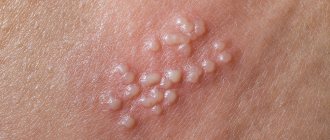| Appointment with a dermatologist at the clinic. Call a dermatologist at home. | Reception is strictly by appointment, make an appointment by phone: +7 | Prices for services | Reviews about the clinic |
A rash during pregnancy can be quite common due to the fact that the female body undergoes many different changes. Many organs are literally rebuilt and then begin to function differently from how they worked before. Naturally, this may be reflected in a woman’s appearance.
If any rashes occur, there is no need to panic - immediately contact a dermatologist. Perhaps these are temporary changes that will go away after pregnancy. Maybe there are some other reasons, by identifying and eliminating which you can get rid of the problem itself. In general, hormonal levels are difficult to predict and very individual. For example, during pregnancy, women secrete little estrogen, but other hormones begin to be released abundantly, and it is estrogen that is responsible for protecting the skin from harmful external influences. As a result, you may see:
- inflammatory processes;
- excessive dryness of the skin;
- various rashes and pimples.
Make an appointment with a dermatologist by phone or by filling out the online form
| Select a clinic | Demodicosis | Rash on shoulders | Calling a dermatologist to your home |
Answers to frequently asked questions about skin rashes:
- Which doctor should you contact for a skin rash?
- Is the skin rash contagious?
- What diet is necessary for skin rashes?
- What diagnosis is needed for a skin rash?
- Why is a skin rash dangerous?
- Why is it necessary to get tested for a skin rash?
- What diseases does a skin rash indicate?
- What examination is necessary for a skin rash?
- Which skin rash is dangerous?
- How to distinguish an allergic rash from an infectious one
- How to get rid of skin rashes?
- How to get rid of itching skin rash?
- What organs are affected by a skin rash?
- How to prepare for an appointment with a dermatologist?
- How to get checked for skin diseases?
- What diseases does a dermatologist treat?
- What tests should be taken by a dermatologist?
- What diagnostics can a dermatologist perform in the clinic?
- Where to go with a skin disease?
Why does a rash form in pregnant women?
The causes of rashes in pregnant women, by their nature, are very diverse, often due to diseases. Typically, these reasons may be:
- Dermatosis is the most common disease in pregnant women. The rash is formed due to a hormonal imbalance in the body, and is observed at the end of the fruiting period. Dermatosis will most likely disappear on its own after childbirth;
- Rubella is very dangerous during pregnancy. It is formed at the beginning of pregnancy in the expectant mother, accompanied by headache, nausea and, naturally, a pale pink rash. The consequences of rubella affect, first of all, the future health of the child. Having had rubella while in the womb, the newborn may develop eye diseases, deafness, cardiovascular system defects, and damage to the nervous system;
- Measles occupies a place equal to rubella, being no less dangerous. Appears in the first 12 weeks of pregnancy and the consequence is termination of pregnancy, causing pathology of the nervous system, including dementia. Accompanied by tuberous rashes spreading throughout the body;
- Herpes is an infectious disease that causes a blistering rash. As the disease progresses, the blisters burst and form ulcers. Infection of the fetus is possible, but not always. When infected at the beginning of pregnancy, damage to the cardiovascular system occurs, at the end of pregnancy: encephalitis, hepatitis, pneumonia;
- Allergies begin when the body is exposed to an allergen. During pregnancy, the mother's body may exhibit special sensitivity to allergens that previously had no adverse effects before exposure to them. An allergic reaction is accompanied by redness of the skin, both in a small area of the skin and developing throughout the body.
And this is not the entire list of diseases that excite and are accompanied by the appearance of a rash. During pregnancy, it is important to preserve not only your health as a mother, but also the future health of the child. In our clinic, mothers of all ages undergo the necessary drug treatment and rehabilitation after illnesses of all types and development.
Serious consequences
During the inflammatory process that accompanies a rash during pregnancy, primary elements arise, and then secondary ones, which aggravate the disease itself, reflecting the general symptoms. For example, eczema is a chronic inflammatory skin disease that causes a rash and other erythematous signs. The cause is considered to be an immune reaction to various irritants.
Sometimes the tendency to eczema is inherited and is expressed by special sensitivity to certain provoking factors:
- Mechanical;
- Thermal.
When eczema forms, the following have an important effect:
- Pathologies in the nervous system.
- Diseases associated with internal organs.
- Endocrine system disorders.
A small rash may soon disappear, after which itchy elements remain that secrete serous exudate. Weeping processes may occur on the skin surface, which are followed by the appearance of scabs that are yellow-brown in color.
Chronic diseases are expressed by severe peeling, cracking, severe dryness and the fact that the skin becomes thicker. Eczema is most often localized on the hands, in the shin area, and sometimes on the face.
Methods for diagnosing skin diseases:
- Diagnosis of skin diseases
- Diagnosis of skin diseases at home
- Diagnosis of allergic skin diseases
- Diagnosis of bacterial skin diseases
- Diagnosis of viral skin diseases
- Diagnosis of hair diseases
- Diagnosis of nail diseases
- Diagnosis of skin tumors
- Skin scraping
- Blisters on the skin
- Dermatoscopy
- Demodex tests
- Diagnosis of sexually transmitted infections
- Mushroom tests
- Skin scraping
Formations like the appearance of a rash
Visually, the manifestations of the rash on the body of pregnant women are no different from its manifestations on the body of an ordinary person. These are all the same: spots, blisters, nodules (papules), bumps, and so on. These are usually manifestations of the primary rash.
The above formations, during the development of the disease, dry out and form dried crusts of inflamed skin, cracks and scars form. As the disease progresses, different types of rashes are accompanied by scratching. Accordingly, if you scratch the rash, the skin is broken, the scratching gets infected, forming pustules, which are much more difficult to get rid of.
Clinical researches
The effectiveness, safety and tolerability of La-Cri products have been clinically proven. The products are recommended by the Union of Pediatricians of Russia. During clinical studies, specialists were able to record that the La-Cri cleansing gel:
- gently cleanses the skin;
- relieves redness and itching;
- restores and nourishes the skin.
Cream for dry skin "La-Cri" eliminates dryness and flaking, retains the skin's own moisture, and also protects it from wind and cold.
Lip balm La Cree:
- relieves the feeling of discomfort and dryness;
- restores dry and cracked lips;
- moisturizes and protects the skin from wind and cold.
Sources:
- Sukolin Gennady Ivanovich, Illustrated clinical dermatology. Brief alphabetical reference book, Lux Print publishing house, 2010.
- Schneiderman Paul, Grossman Mark, Differential diagnosis in dermatology. Atlas, Binom, 2022.
- Reken Martin, Schaller Martin, Sattler Elke, Burgdorf Walter, Atlas of Dermatology, MEDpress-inform, 2022.
Photos of eczema
Photo album on the diseaseLocalization of the rash on the body of pregnant women
Where problems may arise may be:
- Stomach;
- Hands;
- Legs;
- Face.
You can see that a rash on the body of a pregnant woman
very dangerous.
It means the beginning of an inflammatory process that can be transmitted to the future child. Particular care must be taken during the initial and final periods of pregnancy. Contacting a dermatologist
at our clinic during this period will help the expectant mother prevent negative illness and feel good throughout pregnancy.
This article does not constitute medical advice and should not serve as a substitute for consultation with a physician.
Cosmetics La Cree - an assistant to the expectant mother
The La-Cri series is a non-hormonal anti-inflammatory product with a natural composition for the care of skin prone to itching. They are sold in pharmacies and do not contain hormones, fragrances, dyes, silicones and parabens.
The complex composition, including natural components, effectively affects all manifestations of skin inflammation: redness, itching, irritation and peeling. Thanks to its safe composition, La-Cri products are approved for use when hands itch during pregnancy.
Postpartum thrombophlebitis
Thrombophlebitis can develop in a woman not only during childbirth, but also after it. It usually begins 2-3 weeks after birth and can spread from inflamed veins in the uterus. Often a young mother complains not only of pain, but of chills, general deterioration of her condition, and fever. However, these are symptoms not of a cold, but of thrombophlebitis, which cannot be ignored.
Thrombophlebitis is undoubtedly one of the most serious complications of varicose veins. However, knowing about its symptoms, the disease can be detected in time and measures can be taken. Be attentive to yourself, and this will help you maintain the beauty and health of your feet for a long time!
What is thrombophlebitis?
Thrombophlebitis is an inflammatory process in the veins, which is accompanied by the formation of blood clots, that is, blood clots themselves.
Clots begin to grow near the vein and gradually spread throughout the vessel. If the vein is of small diameter, a tributary of the main trunk, then it can be completely closed by a blood clot, but this does not pose a serious threat to health and life. If clots form in large veins in the legs, then it is dangerous for them to spread into the inferior vena cava system or break off a blood clot. Thrombophlebitis develops against the background of slow venous blood flow, which occurs with varicose veins. If an injury to the venous wall is added to this (and a distended vein is also damage), then this is an additional factor that contributes to the onset of blood clot formation.
Dermatoses during pregnancy
Pregnancy is a unique physiological state of a woman, characterized by numerous changes in almost all organs and organ systems. The skin is no exception - under the influence of hormonal changes, it also experiences reactions that are not typical for any other condition of a woman outside of pregnancy.
Dermatoses during pregnancy
The skin of a pregnant woman may become dry or, conversely, moist (a pregnant woman sweats more often), its oiliness increases, and rashes appear in the form of pustules and acne. The sensitivity of the skin to sunlight often increases, which can be accompanied by burns, phytodermatoses, and the appearance of age spots. Stretch marks, which some women are so afraid of, are associated with rapid changes in body shape, when even women’s elastic skin, genetically predisposed to stretching, may not keep up with the growth of the fetus.
Types of dermatoses in pregnant women
Various types of rashes on the skin of a pregnant woman can appear for the same reasons as in a non-pregnant woman. But there is a group of so-called pregnancy dermatoses , which are characterized by a specific skin condition and do not occur outside of pregnancy.
This group includes only four diseases, or rather skin conditions , which most often do not require any special treatment:
- atopic dermatitis (dermatosis) of pregnant women;
- polymorphic dermatosis of pregnant women;
- pemphigoid of pregnancy;
- intrahepatic cholestasis of pregnancy.
In fact, there is still some confusion in the classification of dermatoses of pregnancy, which is due to insufficient study of this topic in obstetrics. Doctors often call any itching and rashes during pregnancy the same thing - pregnancy itch , if other causes of its occurrence (primarily infection) are excluded.
Obstetrician-gynecologists, to whom pregnant patients complain of rashes and itching, do not know how to diagnose dermatoses. In turn, most dermatologists do not understand skin changes associated with pregnancy, that is, they are not familiar with dermatoses of pregnant women. Infectious disease specialists usually conduct a targeted search for some infectious diseases and often overuse diagnoses. Therapists blame the liver for everything and cling to minor deviations in liver function tests, which is also not uncommon during pregnancy, especially in the third trimester, and then carry out extremely aggressive inpatient treatment. Due to these circumstances, most dermatoses of pregnancy remain undiagnosed or are recorded in pregnancy histories under false diagnoses.
Reasons for the development of dermatoses in pregnant women
No one knows for sure the reasons for the development of dermatoses in pregnant women, but it is believed that they appear due to changes in the status of the woman’s immunological system during pregnancy.
In general, a person has two types of immunity: cellular and humoral, between which there is a certain balance. Cellular immunity usually dominates humoral immunity and is characterized by the activity of cells that perform various protective functions in the human body, such as the production of antibodies. Humoral immunity is characterized by the production of certain substances that can perform a protective role both through the activation of other cells and directly through the destruction of foreign cells and substances.
During pregnancy, when the mother's body needs to accept and carry a body that is foreign to it - the fetus, a shift in the balance of two immunities occurs and humoral immunity begins to dominate. At the same time, skin cells become more sensitive not only to environmental factors, but also to many substances produced by a woman’s body during pregnancy. Most often, dermatoses appear at the end of pregnancy - in the third trimester, although in some cases a skin reaction can be observed earlier.
Atopic dermatitis of pregnancy (AEP)
Atopic dermatitis of pregnancy is diagnosed in 50% of cases of dermatosis in pregnant women. AEP includes three conditions: eczema of pregnancy, prurigo of pregnancy, and pruritic folliculitis of pregnancy. Only an experienced specialist can distinguish three different itching conditions in pregnant women from each other. Another name for this dermatosis is prurigo of pregnancy. In addition to itching, a rash (papular) or eczema may occur on the skin. In fact, all three conditions are manifestations of atopic dermatitis, although they may be mistakenly called by different names.
With eczema of pregnancy (EP), changes in the skin are most often observed in unusual places (atypical) - for example, in the neck, on the flexor surfaces of the arms and legs, palms, soles, face, which can be mistakenly associated with some kind of mechanical injury (collar ) or fungal skin infection (candidiasis). In this case, an increased level of IgE antibodies is often found in the blood (up to 70% of cases). Many women have a predisposition to atopic dermatitis outside of pregnancy, although for the first time such a reaction appears in 80% of women during pregnancy. When diagnosing, family history is taken into account - many pregnant women with eczema have relatives suffering from atopic dermatitis.
Eczema of pregnancy occurs more often during the first pregnancy with one fetus. The rash and itching are localized and usually appear in the first and second trimester. This type of dermatosis does not pose a danger to the fetus and does not complicate the outcome of pregnancy. As treatment, ointments and creams containing painkillers, antihistamines, and steroids are used, that is, the treatment is symptomatic. After childbirth, eczema usually goes away on its own and very quickly.
Prurigo of pregnancy (PP) occurs in one case in 300 pregnant women. This condition is characterized not only by itching, but also by the appearance of rashes in the form of small nodules (papules), mainly on the legs and arms, as well as on the abdomen. Prurigo can occur in any trimester. This condition is not dangerous for pregnancy and the fetus, although it is unpleasant. Treatment is usually symptomatic, but most often it is ineffective.
Pruritic folliculitis of pregnancy (PF ) affects one in 3,000 pregnant women and occurs most often in the second and third trimesters. Despite the name, the main symptom of this skin condition is not itching, but a large number of nodules measuring 2–4 mm. The rash affects the skin of the shoulders, back, chest, and less often the abdomen, so folliculitis is often mistaken for acne or a skin infection (staphylococcal, streptococcal). Although such a rash looks like a bacterial one, it does not pose a danger to the pregnant woman and the fetus, because histological examination of such nodules shows foci of sterile inflammation (without a pathogen). Itchy folliculitis in pregnant women usually goes away on its own, without treatment, within 1–2 months after birth. For severe itching, topical use of benzene peroxide has worked well.
Polymorphic dermatosis of pregnancy (PEP)
Polymorphic dermatosis of pregnancy is characterized by an itchy rash in the form of urticarial nodules (papules), plaques and even blisters. This is the second most common dermatosis of pregnant women (after eczema of pregnancy) - it occurs in 1 case in 160 pregnancies. It is most often seen in repeat pregnancies, especially in women who are overweight or have gained a lot of weight during pregnancy, and usually in the third trimester. It is interesting that the first episode of this dermatosis can occur even after childbirth - naturally, neither the woman nor the doctor will connect this with pregnancy. And only during subsequent pregnancies will polymorphic dermatosis manifest itself again. It is also what most often occurs in multiple pregnancies.
Since the rashes with this type of dermatosis are varied (not homogeneous), it is called polymorphic. At first, it can be confused with other types of dermatoses of pregnancy, but usually the rash appears first on the skin of the abdomen, including stretch marks (striae gravidarum), but without affecting the skin in the navel area. Gradually, the rash can spread to the mammary glands, thighs, and arms. The face, palms, soles and mucous surfaces of the oral cavity with polymorphic dermatosis, as a rule, remain clean, without rash.
Unlike other dermatoses, polymorphic dermatosis of pregnancy may disappear without treatment in the last weeks of pregnancy. This type of dermatosis does not pose a danger to the mother, fetus and newborn and rarely requires symptomatic treatment.
Pemphigoid gravidarum (PG)
In the past, pemphigoid of pregnancy, due to the similarity of the rashes, was called herpes of pregnant women, which was a mistake, since it is not related to the herpes virus, that is, to the infectious process it causes, although it superficially resembles it. This is a very rare disease - it occurs in 1 case in 50,000 pregnancies, most often in the second trimester. This dermatosis is believed to be associated with autoimmune diseases, but its nature is not yet clear to scientists. Its association with human leukocyte antigens HLA-DR3 and HLA-DR4 is observed. Many women with pemphigoid suffer from autoimmune thyroiditis and a number of other autoimmune diseases. Pemphigoid of pregnancy is also more common in women with trophoblastic disease (hydatidiform mole, chorionepithelioma).
With each new pregnancy, the risk of developing pregnancy pemphigoid increases, if it was observed during the first pregnancy, and the disease now begins at an earlier and earlier stage.
The rash first appears in the navel area in the form of papules and plaques, which then develop into blisters, most often in the third trimester. Later, the rash can spread to the skin of the chest, back, thighs, and arms. This type of dermatosis also affects the mucous membranes. In general, pemphigoid in pregnancy resembles the autoimmune disease - vesicular pemphigoid, but dermatosis in pregnancy is a benign condition.
In many pregnant women, this dermatosis subsides by the end of the third trimester, but in 75% of pregnant women it worsens during childbirth. After childbirth, this dermatosis usually goes away without treatment. In a number of women, pemphigoid rash is also observed when taking hormonal contraceptives and during menstruation.
Because this type of dermatosis is accompanied by the production of IgG antibodies, they can cross the placenta, and 5-10% of newborns have a variety of rashes (from papules and blisters to blisters). There has also been an association between pregnancy pemphigoid and an increased risk of preterm birth and low birth weight babies.
Treatment is rarely required and is usually used to relieve itching. Preparations containing glucocorticoids are effective.
Intrahepatic cholestasis of pregnancy (ICP)
The most common name for this condition is itch gravidarum. In the past, this dermatosis was also called jaundice of pregnancy and obstetric cholestasis. Unlike all other dermatoses, intrahepatic cholestasis of pregnancy is not accompanied by skin rashes (rashes are very rare). It begins immediately with itching, often on the palms and soles, and gradually spreads to other parts of the body. The itching gradually becomes so intense that it leads to noticeable scratching of the skin.
The hereditary nature of this condition has also been established - it often occurs in the female line and in the presence of human leukocyte antigen A31 (HLA A-A31) and HLA-B8.
Women with pruritus gravidarum typically have a family history of gallstones. 10% have jaundice during pregnancy. This type of dermatosis can be accompanied by changes in the levels of a number of blood substances: an increase in the level of bile acids, liver tests (up to 70% of cases) and often bilirubin, which is not dangerous for a pregnant woman in the vast majority of cases.
Intrahepatic cholestasis in pregnancy is fraught with premature birth and the risk of intrauterine fetal death, which is associated with the toxic effects of bile acids. But usually an unfavorable pregnancy outcome is observed only with a significant increase in the level of bile acids. With prolonged cholestasis and in severe cases, vitamin K deficiency and blood clotting disorders may occur.
Pregnancy itch is very difficult to treat. Antihistamines are most often used, although their effectiveness is known to be low. Recently, ursodeoxycholic acid (UDCA) has been used, which lowers the level of bile acids and reduces itching, but not in all pregnant women. Corticosteroids are less commonly prescribed. Sometimes, if treatment is ineffective, antidepressants and a number of drugs that reduce the conductivity of nerve impulses and suppress the reactions of the nervous system can be prescribed.
If pregnancy itching is severe, one of the ways to alleviate a woman’s condition may be to terminate the pregnancy, especially in the later stages, when the survival rate of newborns is already quite high.
Principles for diagnosing dermatoses of pregnancy
In addition to the clinical picture and changes in a number of blood parameters, the type of dermatoses can be determined by studying the histological structure of rashes and changes in the skin - all dermatoses have a specific histological picture, but not all doctors recommend and not all women agree to undergo a skin biopsy during pregnancy.
It is necessary to understand that there are a large number of diseases that can be accompanied by itching and rashes on the skin, so dermatoses of pregnancy are rather diagnoses of exclusion, despite their prevalence, than primary diagnoses. In many cases, it is first necessary to exclude infectious diseases (one of the most common is scabies), an allergic reaction, liver diseases (viral hepatitis), kidney diseases, blood diseases (polycythemia, lymphoma) and other diseases, and the history of past pregnancies, personal and family history.
In conclusion, I hasten to reassure women - in general, dermatoses of pregnancy are not dangerous diseases, although they are usually accompanied by an extremely unpleasant symptom - itching. This creates discomfort, disrupts a woman’s sleep and peace, and causes additional stress. In such cases, it is necessary to find the best course of action to alleviate the condition of the pregnant woman.
Share link:
- Click to share on WhatsApp (Opens in new window)
- Click to share on Telegram (Opens in new window)
- Click here to share content on Facebook. (Opens in a new window)
- Click to share on Twitter (Opens in new window)
- Click to share on Skype (Opens in new window)
- Send this to a friend (Opens in new window)
- Click to print (Opens in new window)









